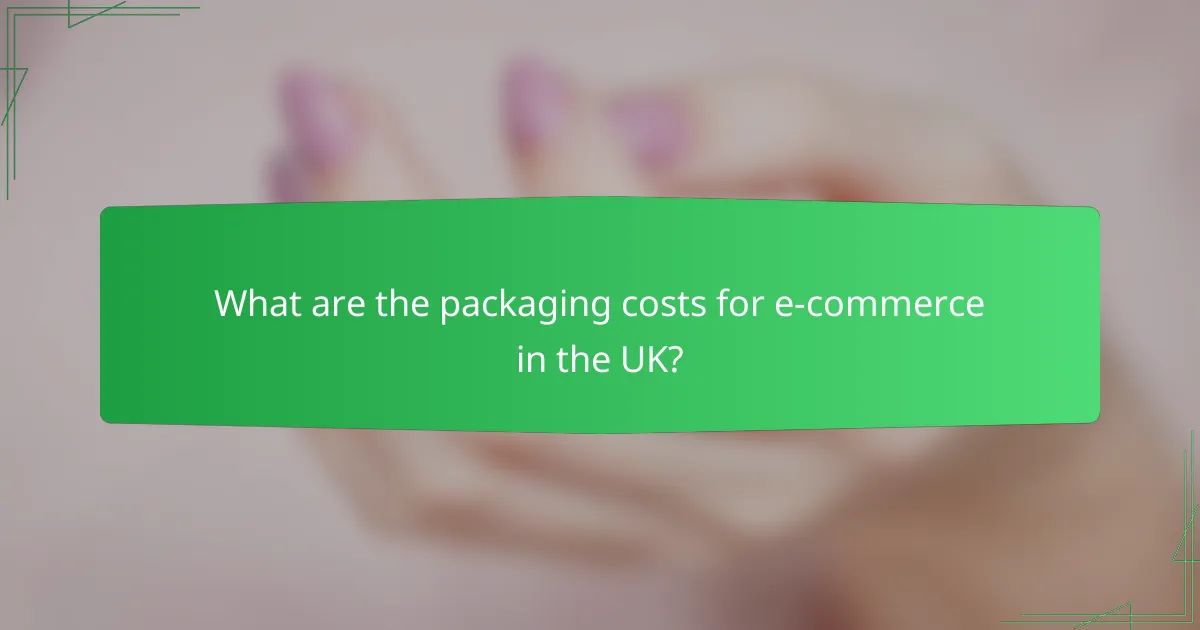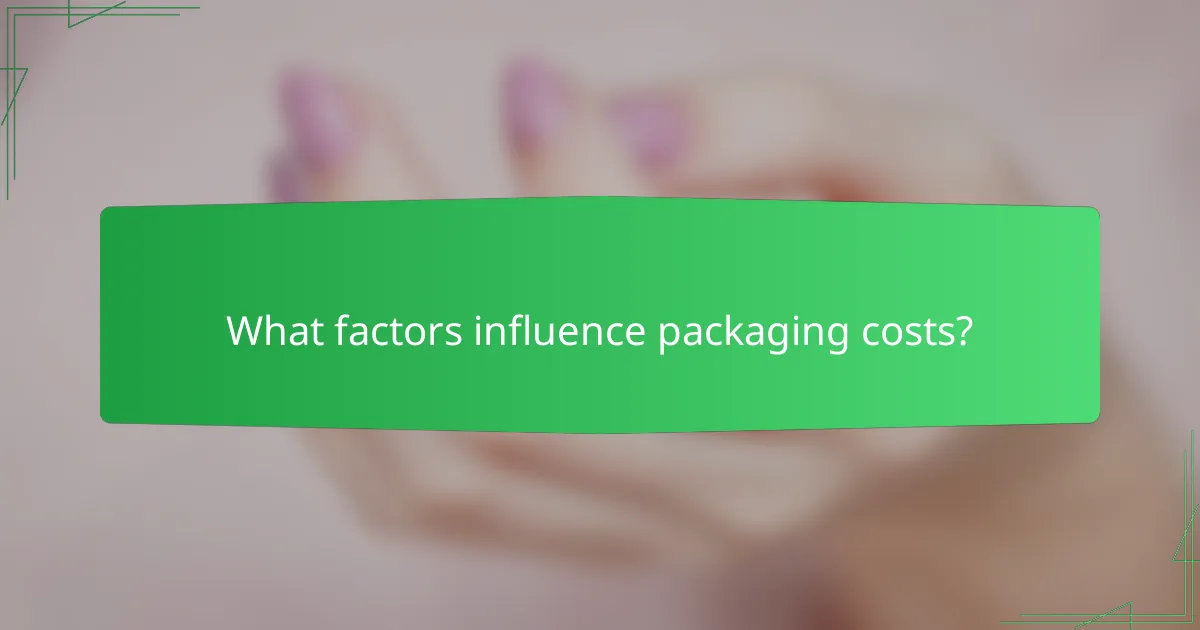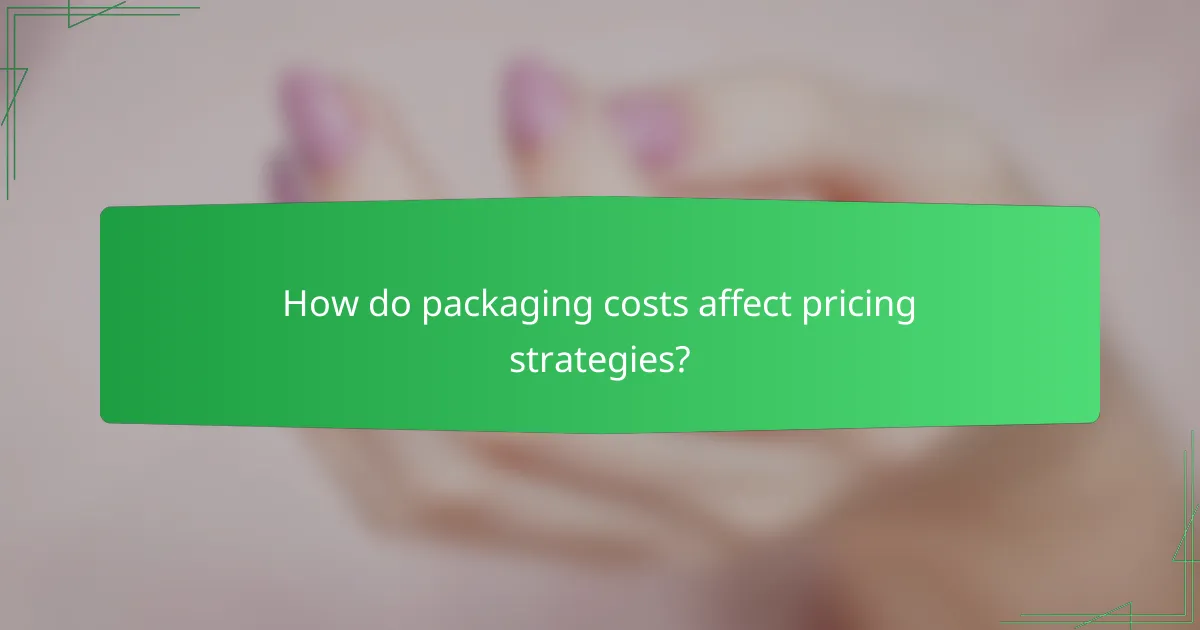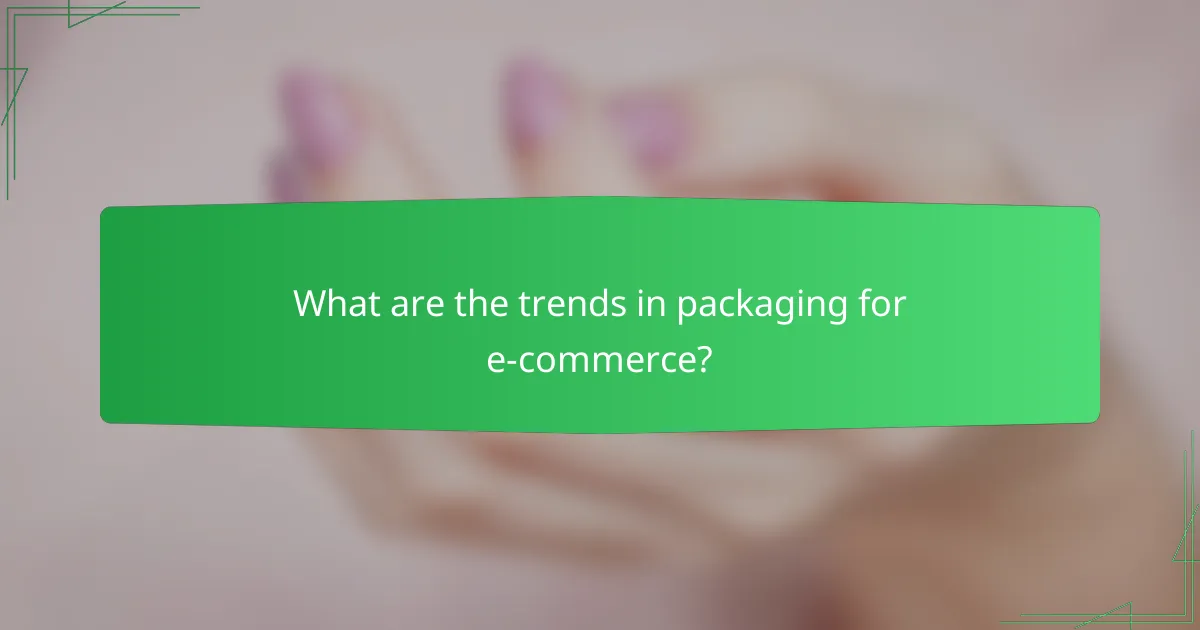Packaging costs in e-commerce involve several key components, such as branding materials, protective packaging, and presentation expenses. A thorough understanding of these costs is essential for effective budgeting and enhancing the customer experience. By optimizing material choices and presentation techniques, businesses can achieve significant savings while reinforcing their brand identity.

What are the packaging costs for e-commerce in the UK?
The packaging costs for e-commerce in the UK encompass various elements, including branding materials, protective packaging, and presentation expenses. Understanding these costs is crucial for budgeting and optimizing the overall customer experience.
Branding materials costs
Branding materials costs include items like custom boxes, tape, labels, and inserts that showcase your brand identity. These materials can range from a few pence for basic labels to several pounds for high-quality, printed boxes.
When selecting branding materials, consider the balance between quality and cost. Investing in distinctive packaging can enhance customer perception and loyalty, but it’s essential to avoid overspending on unnecessary features.
Protective packaging costs
Protective packaging costs cover materials designed to safeguard products during transit, such as bubble wrap, foam inserts, and air pillows. Depending on the fragility of the items, these costs can vary widely, typically from a few pence to several pounds per package.
To optimize protective packaging expenses, assess the fragility of your products and choose materials that provide adequate protection without excessive bulk. Avoid common pitfalls like underestimating the need for protection, which can lead to damaged goods and increased returns.
Presentation expenses
Presentation expenses refer to the costs associated with the overall unboxing experience, including tissue paper, thank-you notes, and branded stickers. These costs can add up, often ranging from a few pence to a couple of pounds per order.
Enhancing the presentation can significantly impact customer satisfaction. Consider incorporating small, thoughtful touches that align with your brand while keeping costs manageable. Avoid cluttering the package with excessive materials, as this can detract from the overall experience.

How can I reduce packaging costs?
To reduce packaging costs, focus on optimizing material choices, purchasing strategies, and presentation techniques. Implementing bulk purchasing, using eco-friendly materials, and enhancing presentation can lead to significant savings while maintaining quality.
Bulk purchasing options
Bulk purchasing can significantly lower packaging costs by taking advantage of volume discounts. Suppliers often offer reduced prices for larger quantities, which can lead to savings of 10-30% compared to buying smaller amounts.
When considering bulk purchases, evaluate your storage capacity and the shelf life of materials. Ensure that you can manage the inventory effectively without incurring additional costs from spoilage or storage fees.
Establish relationships with suppliers who can provide consistent quality and pricing. Regularly review your packaging needs to adjust orders accordingly and avoid overstocking.
Eco-friendly materials
Using eco-friendly materials can not only reduce costs but also enhance your brand’s image. Materials like recycled cardboard or biodegradable plastics often come at competitive prices, especially when sourced from sustainable suppliers.
Consider the long-term benefits of eco-friendly packaging, such as attracting environmentally conscious consumers and potentially qualifying for tax incentives or grants. Research local regulations regarding sustainable packaging to ensure compliance and capitalize on available support.
Evaluate the trade-offs between cost and sustainability. While some eco-friendly options may have a higher upfront cost, the overall savings from waste reduction and improved customer loyalty can outweigh these initial expenses.

What are the benefits of custom packaging?
Custom packaging offers significant advantages, including enhanced brand recognition and improved customer experience. By tailoring packaging to reflect brand identity, businesses can create memorable impressions that resonate with consumers.
Brand recognition
Custom packaging plays a crucial role in establishing and reinforcing brand recognition. Unique designs, colors, and logos help products stand out on shelves, making it easier for customers to identify and remember a brand. For example, a distinctive box shape or a signature color scheme can become synonymous with a brand, fostering loyalty.
To maximize brand recognition, consider incorporating elements that reflect your brand’s values and story. Consistency in packaging across product lines also strengthens brand identity, making it easier for consumers to connect with your offerings.
Customer experience enhancement
Custom packaging significantly enhances the overall customer experience by adding a personal touch. Thoughtfully designed packaging can evoke emotions and create excitement during unboxing, which is a critical moment for customer satisfaction. For instance, including a thank-you note or using eco-friendly materials can positively influence customer perceptions.
When designing packaging, prioritize functionality alongside aesthetics. Ensure that protective packaging effectively safeguards products during transit while also being easy to open. This balance can lead to higher customer retention and positive word-of-mouth, ultimately benefiting your business.

What factors influence packaging costs?
Packaging costs are influenced by several key factors, including material type, order volume, and shipping requirements. Understanding these elements can help businesses optimize their packaging strategies and manage expenses effectively.
Material type
The type of material used for packaging significantly impacts costs. Common materials include cardboard, plastic, and biodegradable options, each with varying price points. For instance, eco-friendly materials may be more expensive upfront but can enhance brand image and appeal to environmentally conscious consumers.
When selecting materials, consider durability and protection. For fragile items, investing in thicker cardboard or cushioned packaging may reduce damage during transit, ultimately saving costs associated with returns and replacements.
Order volume
Order volume plays a crucial role in determining packaging costs. Larger orders often benefit from economies of scale, resulting in lower per-unit packaging expenses. Businesses can negotiate better rates with suppliers when committing to higher quantities, which can lead to significant savings.
However, smaller orders may incur higher costs due to minimum order requirements or less favorable pricing. It’s important to assess whether consolidating orders or adjusting inventory strategies could lead to cost reductions in packaging.
Shipping requirements
Shipping requirements directly affect packaging costs, as different carriers and shipping methods have varying standards. For example, items requiring expedited shipping may need more robust packaging to withstand faster handling, which can increase costs.
Additionally, dimensional weight pricing used by many carriers means that the size of the package can influence shipping fees. Businesses should optimize packaging size to avoid unnecessary charges while ensuring adequate protection for the product during transit.

How do packaging costs affect pricing strategies?
Packaging costs significantly influence pricing strategies by determining the overall cost structure of a product. Higher packaging expenses can lead to increased retail prices, impacting consumer perception and demand.
Impact on profit margins
Packaging costs directly affect profit margins by influencing the total cost of goods sold (COGS). If packaging expenses are high, businesses may need to raise prices to maintain profitability, potentially reducing sales volume. For example, if packaging accounts for 10-20% of the total product cost, even a small increase can lead to noticeable margin compression.
To optimize profit margins, companies should evaluate their packaging choices. Investing in efficient, cost-effective materials can help balance quality and expense, ensuring that margins remain healthy without compromising product appeal.
Competitive pricing considerations
In a competitive market, packaging costs can dictate pricing strategies relative to competitors. If a business’s packaging is more expensive than others in the same category, it may struggle to compete unless it can justify the higher price through perceived value or brand strength. Understanding competitor packaging strategies is crucial for positioning.
Additionally, businesses should consider consumer expectations regarding packaging. Eco-friendly or premium packaging may justify higher prices, while basic packaging might be necessary for budget-conscious markets. Regularly assessing market trends can help adjust pricing strategies effectively.

What are the trends in packaging for e-commerce?
Trends in e-commerce packaging focus on sustainability, technology integration, and enhancing customer experience. Businesses are increasingly adopting eco-friendly materials and innovative solutions to meet consumer demands and reduce environmental impact.
Sustainable packaging solutions
Sustainable packaging solutions prioritize eco-friendly materials and practices to minimize waste. Options include biodegradable plastics, recycled materials, and reusable packaging systems. Brands that adopt these solutions not only appeal to environmentally conscious consumers but may also benefit from reduced disposal costs.
For instance, companies can use materials like kraft paper or plant-based plastics, which are often more affordable than traditional options. Additionally, implementing a take-back program for packaging can further enhance sustainability efforts while fostering customer loyalty.
Smart packaging technology
Smart packaging technology incorporates features like QR codes, sensors, and RFID tags to enhance the user experience and improve supply chain efficiency. These technologies allow businesses to track products in real-time, ensuring better inventory management and reducing losses.
For example, a brand might use QR codes on packaging to provide customers with product information or promotional offers. This not only adds value but also engages consumers directly, encouraging repeat purchases. However, it’s essential to balance the cost of implementing smart technology with the potential benefits to ensure a positive return on investment.

How do I choose the right packaging supplier?
Choosing the right packaging supplier involves assessing their reliability, quality of materials, and alignment with your branding needs. Prioritize suppliers who can meet your specific requirements while providing consistent service and support.
Supplier reliability
Supplier reliability is crucial for maintaining your production schedule and ensuring product quality. Look for suppliers with a proven track record of timely deliveries and consistent product quality.
Check references and reviews from other businesses in your industry to gauge their reliability. A reliable supplier should also have contingency plans in place for potential disruptions, such as raw material shortages or transportation issues.
Consider establishing a trial period with a new supplier to evaluate their performance before committing to a long-term contract. This can help you identify any potential issues early on and ensure they meet your expectations.
